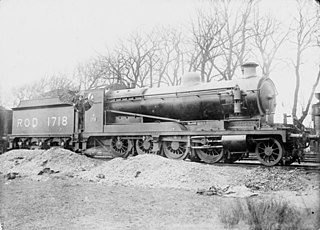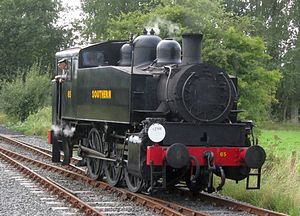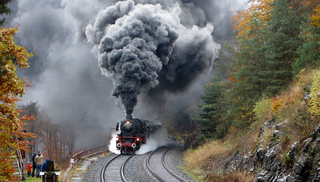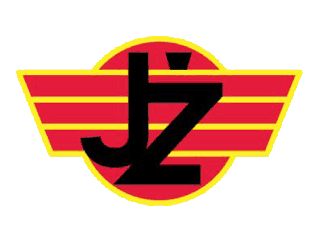
The London Midland and Scottish Railway's 8F class 2-8-0 heavy freight locomotive is a class of steam locomotive designed for hauling heavy freight. 852 were built between 1935 and 1946, as a freight version of William Stanier's successful Black Five, and the class saw extensive service overseas during and after the Second World War.
The United States Army Transportation Corps S160 Class is a class of 2-8-0 Consolidation steam locomotive designed for use in Europe during World War II for heavy freight work. A total of 2,120 were built and they worked on railroads across the world, including Africa, Asia, all of Europe and South America.

The United States Army Transportation Corps (USATC) S200 Class is a class of 2-8-2 steam locomotive. They were introduced in 1941 and lent-leased to the United Kingdom for use in the Middle East during World War II.

The United States Army Transportation Corps (USATC) S118 Class is a class of 2-8-2 steam locomotive. Built to either 3 ft, 1,000 mmmetre gauge or 3 ft 6 in gauge, they were used in at least 24 different countries across the World.

The SR USA class were ex-United States Army Transportation Corps S100 Class steam locomotives purchased and adapted by the Southern Railway (SR) after the end of the Second World War to replace the LSWR B4 class then working in Southampton Docks. SR staff nicknamed them "Yank Tanks".

The EMD G8 was a General Motors-built diesel-electric locomotive of which 382 were built between 1954 and 1965 for both export and domestic use. They were built by both Electro-Motive Division in the United States and by General Motors Diesel Division in Canada for use in ten countries, being equipped to operate on several different track gauges.

The Railway Operating Division (ROD) ROD 2-8-0 is a type of 2-8-0 steam locomotive which was the standard heavy freight locomotive operated in Europe by the ROD during the First World War.
Israel Railway Museum is the national railway museum of Israel, located in Haifa. The railway museum is owned by Israel Railways and is located at the Haifa East Railway Station which nowadays no longer serves passengers.

The LNWR 17in Coal Engine was a class of 0-6-0 steam tender engines designed by Francis Webb for the London and North Western Railway. They were simple locomotives and in UK service they were very reliable. "17in" refers to their cylinder diameter in inches. They were called "Coal Engines" because they were used for hauling coal trains.

The EMD G16 is a diesel locomotive built by General Motors in the USA and under licence by Clyde Engineering in Australia and MACOSA in Spain. It has been used in Australia, Brazil, Egyptian Railways, Hong Kong, Israel Railways, Mexico, Spain, Yugoslav Railways and on the successor Croatian Railways, Slovenian Railways, Serbian Railways, Macedonian Railways, Railways of Republika Srpska, Kosovo Railways and Railways of Bosnia and Herzegovina Federation.
The Ferrovie dello Stato Class 737 consisted of 15 ex-British War Department locomotives of the Stanier Class 8F type purchased in 1946.

The LSWR 395 class was a class of goods 0-6-0 steam locomotives designed for the London and South Western Railway by William Adams as part of his modernisation programme. All 70 were constructed by Neilson and Company between 1881 and 1886. The last 34 locomotives differed in being slightly longer and heavier.

Palestine Railways was a government-owned railway company that ran all public railways in the League of Nations mandate territory of Palestine from 1920 until 1948. Its main line linked El Kantara in Egypt with Haifa. Branches served Jaffa, Jerusalem, Acre and the Jezreel Valley.
The Queensland Railways AC16 class locomotive was a class of 2-8-2 steam locomotives operated by the Queensland Railways.

The Palestine Railways H class was a type of standard gauge mixed traffic steam locomotive on the Palestine Military Railway and its civilian successors Palestine Railways and Israel Railways. The PMR introduced the class in 1919 and Israel Railways withdrew the last ones in 1960.

The Palestine Railways P class was a type of standard gauge mixed traffic steam locomotive on Palestine Railways and its successor Israel Railways. The PMR introduced the class in 1935 and Israel Railways withdrew the last ones in 1960.
The Egyptian State Railways 545 class was a type of standard gauge mixed traffic steam locomotive on Egyptian State Railways.
The Egyptian Republic Railways 4211 class was a class of 0-6-0 diesel shunter introduced on Egyptian Republic Railways in the 1950s. Arnold Jung Lokomotivfabrik in Jungenthal, Rheinland-Pfalz, Germany built the first batch of 15 in 1953 and the second batch of 27 in 1955–56.





























